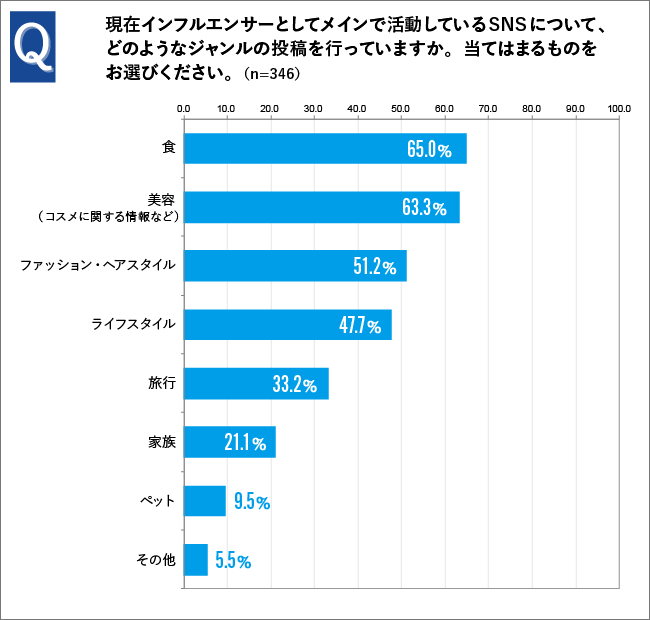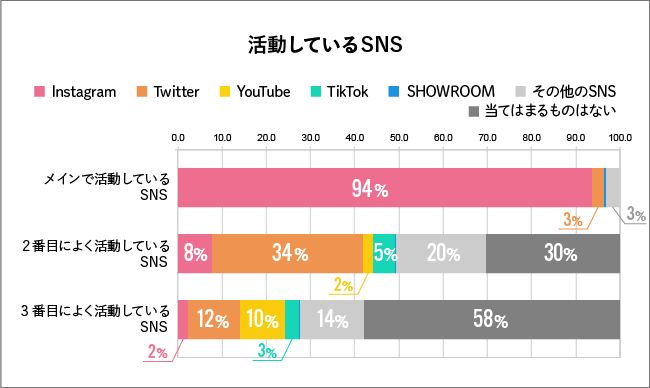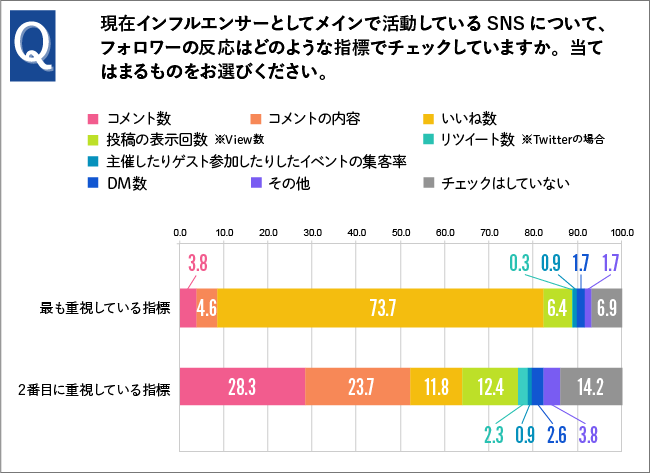Akira Amano explains the second installment of the joint influencer marketing research report by Facebook Japan and Dentsu Inc.
In the 2018 series "Influencer Marketing 2.0," we proposed that maximizing the loyalty and motivation of collaborating influencers is key for the future. Building on that guidance, Part 1 examined desirable approaches for collaborating with influencers and key considerations for achieving better results, based on specific influencer statements and survey findings.
This time, we'll extract insights for the "future" of influencer marketing from a survey of 340 influencers and statements from interviews with four prominent influencers. Signs of evolution are emerging—the expansion of the field, the deepening of relationships between influencers and their fans...
Influencer Reach Expanding Through Hashtags: Insights from the "Food" Genre
First, to understand the current landscape, what genres do influencers most frequently post about? Survey results show food, beauty, fashion/hairstyles, and lifestyle as the leading categories.
While the higher proportion of female respondents in this survey plays a role, even male influencers are posting more in these areas. It seems consumers are seeking content from influencers in these very categories.
Food influencer utosh shared how he created the original hashtag "#とりあえず野菜食" ( roughly: "veggie meal for now" ), which spread among users and drove engagement back to his own posts.
I'd been thinking for a while about creating a vegetable hashtag. I wanted to make one for about half a year. "Vegetarian diet" feels a bit too high a hurdle. It sounds like it might lean into the macrobiotic world, and "vegetarian" isn't quite right either, nor is "let's eat vegetables"... I kept thinking about that. "Vegetables for now" felt just right, like the perfect balance. I thought it was interesting how "for now" counteracts the stiffness of "vegetarian diet." It's funny how we trip ourselves up when we try too hard (utosh)
This hashtag "#とりあえず野菜食" (for now, let's eat vegetables) has spread widely, with about 150,000 posts on Instagram at the time of writing this article. It was even used in utosh's own book title. At first, it was used by people who knew utosh and his fans, but now even people who don't know him are using it.
Although it was posted by an influencer, people who don't know utosh are now using it. In the sense that it is self-propelled by users, it can be considered a manifestation of simulacrum (see: "Video Communication of the Smartphone Native Generation: The Establishment of SNS Search and the Spread of Simulacrum" ).
The Expansion of Influencer Marketing: From Promotion to Product
Which SNS platforms do influencers prioritize for their activities? According to the questionnaire survey results, Instagram stands out as the main SNS platform for their activities. Twitter ranks second, and the third place is shared by several platforms. In addition, 70% of influencers are active on multiple platforms.
Comparing Japan and South Korea, we can mention the proactiveness of South Korean influencers. It was impressive to hear comments that South Korean influencers also place importance on blogs because of their payment functions.
Kim Eun-hye explains her approach:
Instagram is for PR because it's about expressing yourself with a single photo. In other words, I use it as a space for personal branding. I use my blog as a sales channel because it has payment functionality. (Kim Eun-hye)
Moving beyond communication to purchasing. Instagram has implemented shopping features, which are being adopted across various industries, particularly apparel. Going forward, Instagram's checkout feature (currently in trial in the US only; Japan launch date undecided) will enable payments to be completed entirely within Instagram. It's crucial to note this trend of SNS platforms increasingly converging with commerce.
Relatedly, it's interesting that when asked about future goals as influencers, many cited concrete production-oriented goals like developing products with companies. The top three responses were: "Interest in ambassador programs, product development with companies, and deepening connections with fans."
Yukos-san expressed it this way:
I think clients often don't really want to collaborate with influencers on that kind of thing. So, I believe it's actually more considerate towards influencers to avoid meetings, keep things efficient, have the product details all figured out beforehand, and just have them post. (Yukos)
Influencers with ambition consciously seek co-creative partnerships with clients. This mindset, prioritizing the product's merits and the significance of their involvement, will naturally extend to future activities.
This can be rephrased to show that influencer marketing is truly becoming influencer "marketing." Moving beyond mere promotion to the production of the product itself.
Considering this trend, we must also note the growing attention on the D2C Inc. (direct-to-consumer) / DNVB (digitally native vertical brands) space. As the element of Place becomes volatile, we see the current state where influencers are covering the entire spectrum of marketing, replacing the Place element from Kotler's widely advocated marketing 4Ps (product, price, place, promotion).
Several surveys indicate that while both small startups and large corporations are investing in this D2C Inc. space, challenges remain, such as the inability to differentiate themselves from competitors.
One strategy to overcome such "barriers" is the marketing evolution of influencer marketing. This evolution extends the 4Ps from Promotion to Product, and further into controlling Price and Place through D2C Inc./DNVB models.
Unraveling the Relationship Between Fan Communities and Influencers
As everyone becomes a content creator, the traditional asymmetrical dichotomy between information producers and consumers is gradually dissolving. A multi-layered relationship is emerging between creators (influencers) and their audience (fans).
Utosh defines influencers this way:
I consider someone with 1,000 followers to be an influencer. I still get asked this everywhere, but having 1,000 followers gives you the awareness that you're on the side of those who communicate. I believe an influencer is someone who has that awareness of communicating. (utosh)
While follower count is one definition, the core here lies in the "agency of being a content creator." As we'll discuss later, we hypothesize that something more important than follower count exists.
As this kind of information environment becomes more prevalent, more influencers are consciously valuing and emphasizing closeness with their fans. Reina Hoshi mentioned that moving from blogging to Instagram made her fans' faces and lifestyles clearer, and she started being influenced by them too.
When it comes to interacting with fans, Instagram has more posts from people who own their own pages compared to the blog era. People don't come here with weird intentions; many leave comments purely because they genuinely want to know something or ask for advice. Plus, it's fast. You can see posts immediately after logging in and reply right away. So I think it's become a bit more intimate than the blog.
(In the context of "Do you check fans' posts?") Yes, I do. Seeing someone post a lot of photos of their kids, I think, "Oh, they're raising children." Or, "Oh, they really love fashion," or "Oh, this person is a foreign man." You learn all sorts of things. That builds trust. (Reina Hoshi)
This shows how connections and intimate community bonds are deepening. Yukos-san left the keyword "fan-first." More influencers are consciously aware of how their shared content reaches fans.
The survey revealed that metrics like the following seem to be key checkpoints:
Yukos-san says she improves delivery accuracy by picking keywords from magazines her fans are likely reading and turning them into hashtags. The connection to existing media is also a perspective that can't be ignored.
This manicure post came at a time when every magazine was pushing brown. Beauty magazines like ViVi were doing it too. I thought, "Everyone must be curious about brown nails." I incorporated what people were likely searching for. Also, asymmetrical designs with different colors on each hand were trending, so I made sure to include hashtags like "#asymmetricalnails" or "#non-symmetricalnails." (Yukos)
Yukos-san shared her thoughts on connections between fans:
I think regular fans also want a place where they can form loose horizontal connections with each other.
If a hardcore fan of celebrity A asked you, "Wanna go to an event?", wouldn't you hesitate? I doubt many fans would join A's fan club just to build those horizontal connections. (Yukos)
Beyond the influencer-fan relationship, how do we foster connections among fans themselves? This deeply involves awareness of community. We see the influencer's role as a figure who gently guides fans. This ties into the passion discussed in Part 1.
This perspective is crucial because it returns to the fundamental definition of an influencer: someone who can influence their followers' actions, not just someone with a large fanbase or a glamorous appearance/lifestyle. Precisely because the triggers that make people decide to act—whether conscious or unconscious—are diverse, and precisely because their influence can sometimes lead to long-term behavioral changes through fan-like loyalty, like an ambassador, shouldn't the metrics for measuring that influence also be diverse, rather than just follower count or cost per reach?
Meanwhile, as many influencers note, the question of "How can we connect with more passionate fans?" continues to grow in importance. This means balancing the intensity of both sides is the challenge—in other words, there's room for improvement in the matching process.
EVANGELIST FINDER's Passion Metrics, Matching, and Micro-Influencers
At Dentsu Inc., we developed and operate a tool called EVANGELIST FINDER as a solution in the influencer marketing domain. It constantly visualizes not only follower count trends, average engagement rates, and used hashtags, but also follower demographic data, daily posting characteristics analyzed by image AI, and engagement rates for each posting characteristic.
Based on the findings from this research, the team (members include Taichi Nishimura, featured in Part 1, and Shingo Hiraoka, featured in Part 3) developed a metric called the EVANGELIST Score to measure the "passion level" (*) of influencers. After a campaign, influencers are surveyed, and the score is calculated based on NPS analysis. If the EVANGELIST Score is low, various improvement measures (orientation meetings, kickoff events, mid-to-long-term monitoring, etc.) can be proposed to the client to raise it.
While the specific methodology is covered in Part 3 of this series, the key point is that by gauging the influencer's own brand loyalty and observing its impact on fans, we can challenge ourselves to achieve a higher standard in the PDCA cycle of initiatives connecting influencers, fans, and brands.
This EVANGELIST FINDER update focuses on the challenges we currently face and aims to correct the "scale supremacy" mindset. It is nothing less than an attempt to grasp the potential of each individual influencer more accurately and with respect.
In line with this perspective, Duncan Watts (Principal Researcher at Microsoft Research, Professor at Cornell University) also makes an important point in his book The Science of Serendipity (2012). To summarize his argument, when considering how information spreads, we often fall into the illusion of overestimating the role of "influential individuals" among diverse factors. This illusion influences various phenomena. For example, when a movie becomes a hit, we often focus on individuals, saying things like "because the director was XX" or "because the lead actor was XX." In reality, however, the success or failure of a movie's popularity is determined by numerous factors, such as the competitive landscape of other films at the time and its relationship with other leisure activities.
Drawing on insights from his specialty, network science, Watts revealed that information spreads more effectively when disseminated by many moderately influential individuals rather than by a single highly influential one.
In this sense, the idea that micro-influencers (various definitions exist, but generally referring to influential individuals with several thousand to tens of thousands of followers) are more important seems supported by network theory. Adopting a probabilistic perspective and building communication strategies in a portfolio-like manner. This is also a sincere approach rooted in the inherent uncertainty of our communication.
※Engagement Level: The influencer's enthusiasm for recommending products or services to fans and their desire to commit to the brand
【Influencer Survey Overview】
Survey Period: December 2018
Survey Company: Trendenders Inc.
Survey Method: Internet Quantitative Survey
Sample Composition: 346 registered influencers
[Influencer Depth Interview Survey Overview]
Survey Period: December 2018
Research Company: Trendenders Inc.
Survey Method: In-depth interviews (approx. 2 hours). For Korean influencers, interviews recorded locally were reviewed via video.
Sample Composition: 7 prominent influencers across categories such as beauty, food, fashion, etc.








